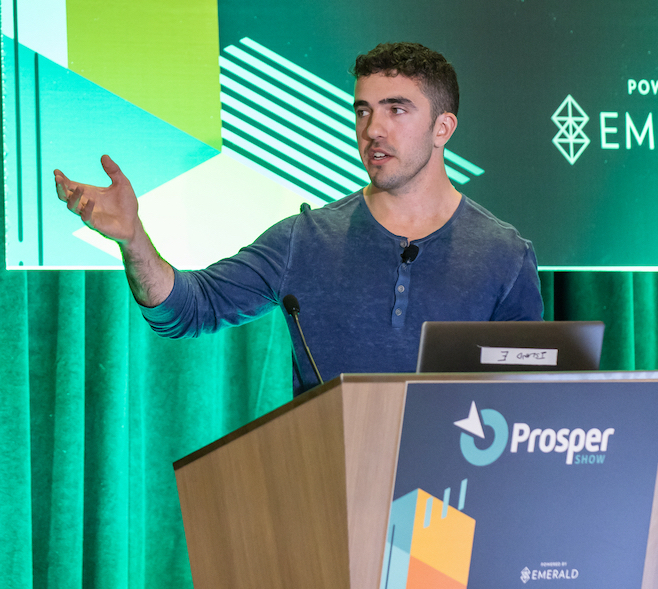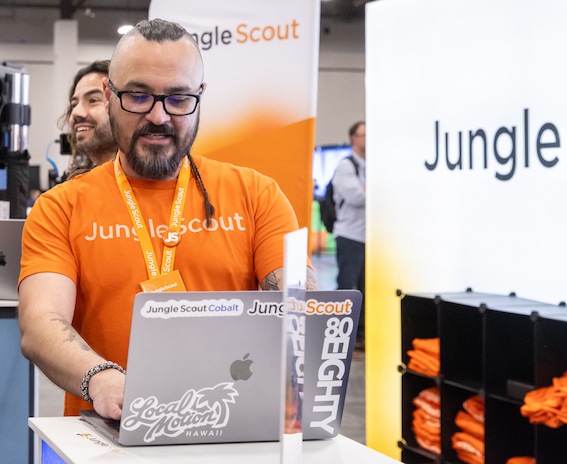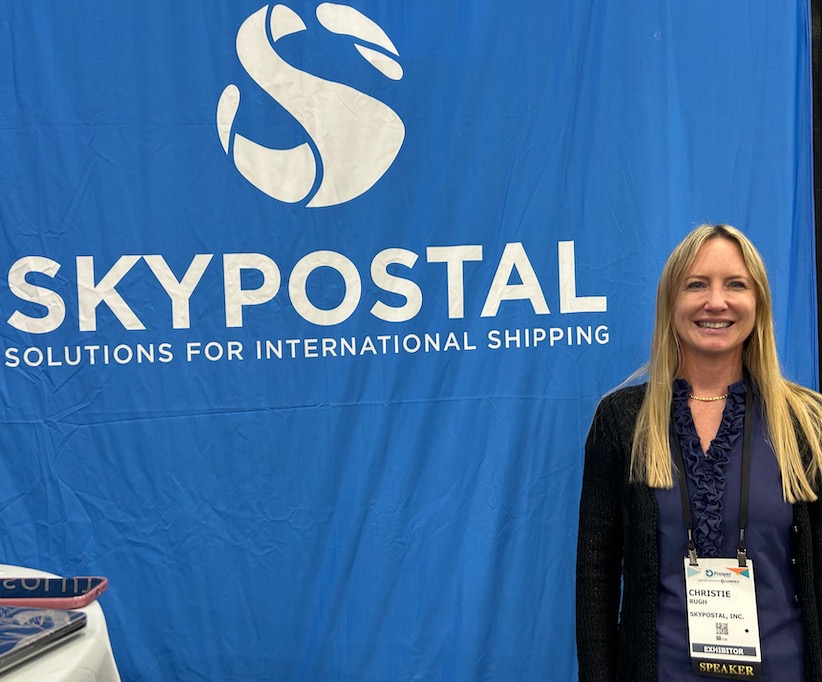April 25, 2025
LAS VEGAS – Its’ been a month since Prosper Show convened in Las Vegas, and since then the tariff situation has ricocheted in whiplash fashion. So-called “Liberation Day” initiatives in early April saw 10% tariffs on all countries with tariffs (as of 4/23) on Chinese imports as high as 145 percent.
Whether the tariff on Chinese imports goes up or down in the coming days, the situation has been fairly tariffying for many online sellers. Prosper Show newsletter asked various industry professionals to react to the ups, downs, and unknowns of recent weeks—here’s what we heard.
 “Initially, we slowed manufacturing POs, advertising, and deals while the dust settled. Two weeks after liberation day, we decided we had to unfreeze our inventory pipeline. We will be importing product at the new higher tariff, but we believe many brands will be left without inventory to sell in a couple of months. This is a huge opportunity for those in-stock. We are looking to manufacturing cost, retailer margin, advertising/deals, and lastly retails to achieve acceptable margin. This is a period that is very challenging but we also see a lot of opportunity to work with partners and propel the brand forward.” — Bryan Porter, co-founder, Simple Modern, and opening Keynote speaker at Prosper Show 2025
“Initially, we slowed manufacturing POs, advertising, and deals while the dust settled. Two weeks after liberation day, we decided we had to unfreeze our inventory pipeline. We will be importing product at the new higher tariff, but we believe many brands will be left without inventory to sell in a couple of months. This is a huge opportunity for those in-stock. We are looking to manufacturing cost, retailer margin, advertising/deals, and lastly retails to achieve acceptable margin. This is a period that is very challenging but we also see a lot of opportunity to work with partners and propel the brand forward.” — Bryan Porter, co-founder, Simple Modern, and opening Keynote speaker at Prosper Show 2025
“Since the tariff change turmoil, Forceget Supply Chain Logistics has seen a 40% increase in interest. The recent tariff whiplash—especially the increases on imports from China have created significant cost pressures and supply chain disruptions for many businesses. Companies are looking for different sourcing, logistics, and compliance strategy options to maintain cash flow and increase profitability.” — Melanie L’Heureux, sales manager, Forceget Supply Chain Logistics
 “As an Amazon seller, the new tariffs basically eliminate all profit from the China supply chain. We’re not talking about a small hit—it’s a full margin wipeout. What’s frustrating is there doesn’t seem to be a clear ask or strategy. It’s not a negotiation; it’s just branding China as the enemy without any defined path forward. If the goal is to boost U.S. manufacturing or diversify supply chains, then sellers like me need support—tax credits, incentives, faster FDA or customs processes for alternative sourcing regions. Right now, it’s all stick, no carrot.” — Dakota Morse, CEO and founder, ALT Group
“As an Amazon seller, the new tariffs basically eliminate all profit from the China supply chain. We’re not talking about a small hit—it’s a full margin wipeout. What’s frustrating is there doesn’t seem to be a clear ask or strategy. It’s not a negotiation; it’s just branding China as the enemy without any defined path forward. If the goal is to boost U.S. manufacturing or diversify supply chains, then sellers like me need support—tax credits, incentives, faster FDA or customs processes for alternative sourcing regions. Right now, it’s all stick, no carrot.” — Dakota Morse, CEO and founder, ALT Group
“There’s definitely a sense of caution in the market right now. Many sellers are taking a wait-and-see approach, reluctant to make sudden moves that could jeopardize competitiveness. Some stocked up earlier in the year anticipating tariff turbulence—a strategic call that’s now paying off. Others are cautiously experimenting with price adjustments, testing how much flexibility they have without risking penalties or losing the buy box. At Feedvisor, we’re helping brands respond with precision, not panic—adjusting pricing strategies in real time to absorb cost pressures while staying compliant with Amazon’s fair pricing policies. It’s a moment that demands control, agility, and data-driven decisions—not overreactions.” — Dani Nadel, president and COO, Feedvisor
 “It’s been chaos and pandemonium. Everyone is in a panic due to all the uncertainty, and speed at which things are changing. In my opinion, this could be a great opportunity for those who have the vision to capitalize on it. Established Enterprise Brands are going to be forced to reevaluate their processes: manufacturing, supply chain, etc. The status quo they’ve relied upon may no longer be the best option, and in all honesty it may not have been the best option for a while. Change is difficult, and sometimes a business needs a jolt like this to improve and evolve.
“It’s been chaos and pandemonium. Everyone is in a panic due to all the uncertainty, and speed at which things are changing. In my opinion, this could be a great opportunity for those who have the vision to capitalize on it. Established Enterprise Brands are going to be forced to reevaluate their processes: manufacturing, supply chain, etc. The status quo they’ve relied upon may no longer be the best option, and in all honesty it may not have been the best option for a while. Change is difficult, and sometimes a business needs a jolt like this to improve and evolve.
“Smaller, nimbler Amazon businesses and sellers are oftentimes better positioned to analyze and implement changes to their processes. Enterprise brands don’t have the flexibility to do the same fast and fluid approach. While I’ve seen lots of doom and gloom on social media about how this may cause ‘my business to fail’—and that is always a possibility, but when is it really not on the table? The right mindset, approach, and execution may see some of these Amazon Sellers soaring to new heights as they outmaneuver their larger counterparts.” — Brandon Bastin, senior enterprise onboarding & training specialist, JungleScout
 “Tariff whiplash feels like trying to steer a car while the road keeps reshaping itself in real-time. It’s unpredictable, disorienting, and tough on businesses trying to make stable plans. The long-term implications are still foggy, but short-term? Everyone’s playing defense.” — Nizar Noorani, founder, SellerChamp
“Tariff whiplash feels like trying to steer a car while the road keeps reshaping itself in real-time. It’s unpredictable, disorienting, and tough on businesses trying to make stable plans. The long-term implications are still foggy, but short-term? Everyone’s playing defense.” — Nizar Noorani, founder, SellerChamp
“Constant tariff changeups are definitely making things more challenging, but the reality is that the globalization of products isn’t going anywhere. The brands that succeed will be the ones who remain flexible and keep pushing forward despite the shifting landscape.” — Josh Hall, owner and founder, Micromercial
“The tariff turbulence has only reinforced what I’ve been saying for months: U.S. sellers need to diversify now—before uncertainty becomes disruption. While CEOs across the U.S. are reporting the lowest confidence since the early days of the pandemic, and economic forecasts are being revised downward, Latin America is heading in the opposite direction. The region’s e-commerce market is projected to hit $270 billion by 2028, with platforms like Amazon Brazil and Mexico, Walmart Chile and Mexico, and TikTok Shop Mexico actively growing and easier than ever to access.
 “At SkyPostal, we’re seeing more brands accelerate their LATAM strategy—not just as a growth play, but as a hedge against volatility in the U.S. and China. Logistics doesn’t have to be the barrier; it can be your launchpad if you’re working with the right partner like SkyPostal. Bottom line is that tariff whiplash may have rattled markets, but it’s also a wake-up call. The smartest sellers are already looking south.” — Christie Rugh, vice president of Sales & Marketing, SkyPostal
“At SkyPostal, we’re seeing more brands accelerate their LATAM strategy—not just as a growth play, but as a hedge against volatility in the U.S. and China. Logistics doesn’t have to be the barrier; it can be your launchpad if you’re working with the right partner like SkyPostal. Bottom line is that tariff whiplash may have rattled markets, but it’s also a wake-up call. The smartest sellers are already looking south.” — Christie Rugh, vice president of Sales & Marketing, SkyPostal
“The whiplash is creating a lot of anxiety for both sellers and shippers. There’s no direction of where this is all going so how does an organization plan ahead? Sadly there appears to be no near term resolve.” — Michael Recchia, national account manager, ePost Global
“Sellers wait and see. The tsunami will hit. Everyone is on edge monitoring everyone else’s prices to see who needs to raise prices first.” — Cardy Chung, founder and CEO, StreetPricer
“Relax. Don’t jump to conclusions and make drastic changes. Take it one day at a time and wait for it to run its course—then evaluate.” — Andrew Maffettone, founder and CEO, BlueTuskr
